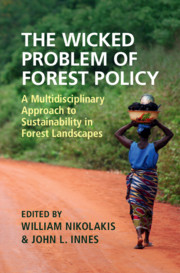 The Wicked Problem of Forest Policy
The Wicked Problem of Forest Policy Tendencies, Impact and the Future of Locally Controlled Forests
from Part II - Tools to Address Wicked Problems
Published online by Cambridge University Press: 24 July 2020
A global trend towards more community control over forests has slowed deforestation and forest degradation, reduced carbon emissions, supported community livelihoods and built social capital. In some cases these positive benefits have not been realized, and there have been mixed results on intra-community equity. Three ‘wicked characteristics’ mitigate the success of community forests: where tenure change erodes the power of economic and technical elites, who then respond by undermining the community forest; where it is difficult to support communities without impacting their collective action; and where governments develop policies that are difficult to adapt to local contexts.
To save this book to your Kindle, first ensure no-reply@cambridge.org is added to your Approved Personal Document E-mail List under your Personal Document Settings on the Manage Your Content and Devices page of your Amazon account. Then enter the ‘name’ part of your Kindle email address below. Find out more about saving to your Kindle.
Note you can select to save to either the @free.kindle.com or @kindle.com variations. ‘@free.kindle.com’ emails are free but can only be saved to your device when it is connected to wi-fi. ‘@kindle.com’ emails can be delivered even when you are not connected to wi-fi, but note that service fees apply.
Find out more about the Kindle Personal Document Service.
To save content items to your account, please confirm that you agree to abide by our usage policies. If this is the first time you use this feature, you will be asked to authorise Cambridge Core to connect with your account. Find out more about saving content to Dropbox.
To save content items to your account, please confirm that you agree to abide by our usage policies. If this is the first time you use this feature, you will be asked to authorise Cambridge Core to connect with your account. Find out more about saving content to Google Drive.